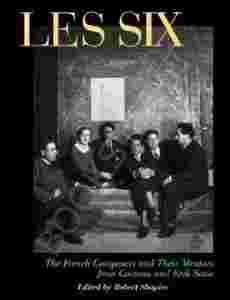|
Les Six were a group of young French composers
consisting of Georges Auric, Louis Durey, Arthur
Honegger, Darius Milhaud, Francis Poulenc and Germaine
Tailleferre, brought together by Erik Satie and Jean
Cocteau at the end of the First World War, who achieved
international fame in the 1920s. A unique collaboration
that has never been matched in classical music, with
Cocteau as their spokesman, Les Six were a phenomenon
born out of the shock of the German invasion of France
in 1914 an avant-garde riposte to the impressionism of
composers such as Claude Debussy and Maurice Ravel and
the romanticism of Richard Wagner and Richard Strauss.
The individual members were already respected in
Parisian musical circles as Les Nouveaux Jeunes before
they became Les Six, but they soon found themselves
moving in an artistic milieu that included Sergei
Diaghilev, René Clair, Pablo Picasso, Georges Braque,
Fernand Léger and the writers Guillaume Apollinaire, Max
Jacob, Raymond Radiguet, Paul Claudel, Maurice Sachs and
Paul Morand. Many fruitful collaborations arose out of
these associations, and Satie would perform with them in
concerts. Les Six continued to perform together
intermittently during the 1920s and later, and most
carried on to have long and distinguished musical
careers, including the only woman of the group,
Tailleferre. Anchored by Robert Shapiro s encyclopaedic
knowledge, and enhanced by contributions from key
commentators Fréderic Robert, Jean Roy, Keith Waters and
Ornella Volta as well as the inclusion of rare
photographs, memorabilia and valuable appendices, this
is the first book in English to examine comprehensively
the legacy of the group. It provides a unique portrait
of artistic Paris in the 1920s and the subsequent
careers of Les Six and those associated with them.
|
|

